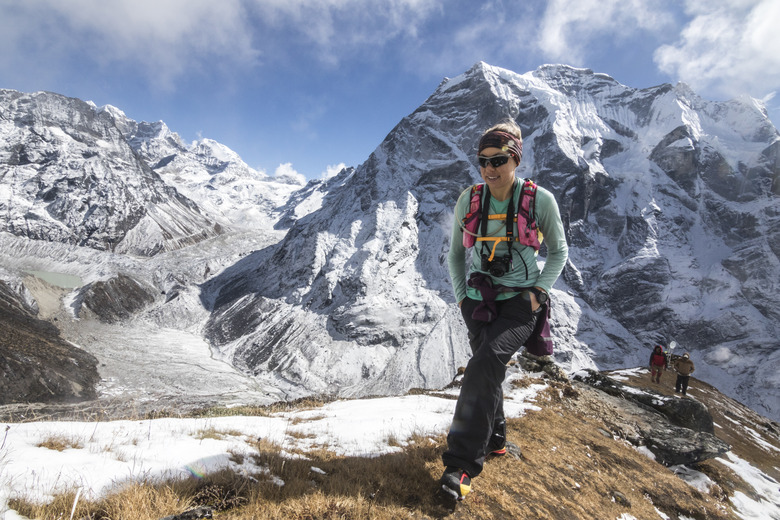Human Uses Of The Tundra
The tundra is a harsh, dry and cold environment with high winds. The tundra biome is the world's coldest biome, where summer temperatures rarely exceed 50 degrees Fahrenheit. The tundra is covered with snow for the majority of the year. Countries where the tundra biome is located include Canada, Russia, Norway and the United States (Alaska).
Plants and Animals of the Tundra
Plants and Animals of the Tundra
The tundra is a treeless plain with low shrubs and other small plants such as mosses and sedges. Lichens are present in abundance and are a critical food source for tundra animals such as caribou. Plants of the tundra tend to be low to the ground in order to survive the high winds, and also tend to have shallow root systems because of the presence of permafrost (frozen soil and organic matter).
Animals that inhabit the tundra include large mammals like polar bears, Arctic foxes, Arctic wolves, caribou, elk and grizzly bears. Small mammals such as marmots, Arctic ground squirrels, ermine and lemmings also thrive. Many bird species live in the tundra biome including both migratory species and year-round residents. Examples of tundra birds include snow geese, snowy owls, ptarmigan, Arctic terns, golden plover, loons, ducks and a variety of songbirds and shorebirds.
Humans and the Tundra
Humans and the Tundra
Humans have been living in the cold, harsh and remote tundra for many thousands of years. The presence of humans on the tundra can be traced back at least 20,000 years to the human migration from the Asian continent to the North American continent which occurred mostly in tundra habitats. Over centuries of living on the tundra, human activity has increased dramatically and the tundra landscape has been changed drastically by residential and industrial development.
On the tundra, human activity includes residential, recreational and industrial uses Many of the permanent residents of tundra regions are indigenous people, such as Alaska's Aleut and Inuit tribes, and rely on subsistence hunting and gathering in order to survive. Recreational opportunities such as hunting and wildlife viewing are available for visitors to the tundra.
Activities of the oil, gas and mining industries have been a subject of controversy as this type of human activity on the tundra causes damage to the delicate tundra ecosystem.
Tundra Resources
Tundra Resources
The Arctic tundra, because of its low population density, amazing wildlife and glorious vistas, is a very popular destination for visitors from all over the world. People travel to the tundra to enjoy activities such as:
- hiking
- fishing
- hunting
- camping
- wildlife viewing
- photography
Animals such as the polar bear, grizzly bear, Arctic wolf and caribou, as well as migratory birds of all sorts, make the Arctic tundra a fascinating destination for outdoor recreational activities.
The Tundra - Human Impact
The Tundra – Human Impact
Recent human impact on the tundra has been damaging and disruptive. The delicate, small plants that grow on the tundra are very easily disturbed. Some tundra plants grow extremely slowly, and because of the already short growing season, these plants have a very hard time recovering from disturbance. Permafrost provides the structure for many tundra habitats, and is very easily damaged especially during the summer thawing period.
Industrial activity is an example of a negative human impact on the tundra. Trucks driving over the delicate tundra landscape leave tire tracks that can be seen decades later. Plants and lichens have a hard time returning to a heavily trafficked area as they recover so very slowly from disturbance. Industrial activity creates an increased risk of toxic chemical spills, as well as increases the thawing of permafrost.
Global climate change is expected to have negative impacts on the tundra and the organisms that live there. The melting of polar ice, thawing of permafrost, introduction of invasive species and increase in pathogens are all examples of the affects of climate change on the tundra environment. These changes can reduce food and habitat availability for native tundra plant and animal species.
Humans can help protect tundra ecosystems in a variety of ways. Reducing or banning certain types of industrial activity would decrease harm to native plants, lichens and permafrost. Switching to alternative energy sources instead of oil or natural gas would limit the need for mining in the tundra. Maintaining refuges, parks and other protected areas within tundra ecosystems is another way to maintain these delicate and unique ecosystems.
Cite This Article
MLA
Reinbold, Joan. "Human Uses Of The Tundra" sciencing.com, https://www.sciencing.com/human-uses-tundra-8111821/. 22 November 2019.
APA
Reinbold, Joan. (2019, November 22). Human Uses Of The Tundra. sciencing.com. Retrieved from https://www.sciencing.com/human-uses-tundra-8111821/
Chicago
Reinbold, Joan. Human Uses Of The Tundra last modified August 30, 2022. https://www.sciencing.com/human-uses-tundra-8111821/
